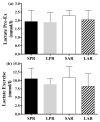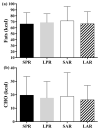Excess Post-Exercise Oxygen Consumption and Substrate Oxidation Following High-Intensity Interval Training: Effects of Recovery Manipulation
- PMID: 35096229
- PMCID: PMC8758170
- DOI: 10.70252/ZMFO1216
Excess Post-Exercise Oxygen Consumption and Substrate Oxidation Following High-Intensity Interval Training: Effects of Recovery Manipulation
Abstract
The recovery manipulation during high-intensity interval training (HIIT) may have the potential to modulate the responses of post-exercise energy metabolism. The purpose of this study was to investigate how the type (i.e., passive and active) and duration (i.e., short and long) of the recovery between the intervals in HIIT affect the excess post-exercise oxygen consumption (EPOC) and oxidation of fats and carbohydrates during the post-exercise recovery. Eight physically active men performed a maximal incremental test, to determine the peak oxygen consumption (V̇O2peak) and the first ventilatory threshold (VT), and four HIIT exercise sessions on a treadmill. The HIIT exercise sessions consisted of 5 intervals interspersed with 4 recovery periods; each interval was sustained until exhaustion, and the intensity was set at the V̇O2peak velocity; recoveries were passive, active (VT velocity), short (2-min), or long (8-min). The HIIT exercise sessions were performed in a random and crossed manner. After the HIIT exercise sessions, EPOC and oxidation of fats and carbohydrates were measured during the 120-min of post-exercise recovery. There were no differences in the EPOC among the exercise sessions (p = 0.56). There were no differences among the exercise sessions in the amount of energy expended on the oxidation of fats (p = 0.78) and carbohydrates (p = 0.91) during the post-exercise recovery. The recovery manipulation during HIIT does not affect the EPOC and post-exercise fat and carbohydrate oxidation. One can choose the type and duration of recovery, knowing that the post-exercise substrate oxidation and EPOC responses will be preserved.
Keywords: Body Weight; Energy Expenditure; Fitness Trends; Respiratory Exchange Ratio.
Figures






Similar articles
-
Acute interval running induces greater excess post-exercise oxygen consumption and lipid oxidation than isocaloric continuous running in men with obesity.Sci Rep. 2024 Apr 22;14(1):9178. doi: 10.1038/s41598-024-59893-9. Sci Rep. 2024. PMID: 38649759 Free PMC article.
-
Acute effects of high-intensity interval training and moderate-intensity continuous training sessions on cardiorespiratory parameters in healthy young men.Eur J Appl Physiol. 2017 Jul;117(7):1437-1444. doi: 10.1007/s00421-017-3636-7. Epub 2017 May 9. Eur J Appl Physiol. 2017. PMID: 28488137 Clinical Trial.
-
Six high-intensity interval training sessions over 5 days increases maximal oxygen uptake, endurance capacity, and sub-maximal exercise fat oxidation as much as 6 high-intensity interval training sessions over 2 weeks.J Sport Health Sci. 2021 Jul;10(4):478-487. doi: 10.1016/j.jshs.2020.06.008. Epub 2020 Jun 18. J Sport Health Sci. 2021. PMID: 32565243 Free PMC article.
-
Mechanistic and methodological perspectives on the impact of intense interval training on post-exercise metabolism.Scand J Med Sci Sports. 2020 Apr;30(4):638-651. doi: 10.1111/sms.13610. Epub 2020 Jan 3. Scand J Med Sci Sports. 2020. PMID: 31830334 Review.
-
[Research progress of the effects of high-intensity interval training on excess post-exercise oxygen consumption in human].Sheng Li Xue Bao. 2024 Oct 25;76(5):849-861. Sheng Li Xue Bao. 2024. PMID: 39468821 Review. Chinese.
Cited by
-
Improvements in Exercise for Alzheimer's Disease: Highlighting FGF21-Induced Cerebrovascular Protection.Neurochem Res. 2025 Feb 4;50(2):95. doi: 10.1007/s11064-025-04350-w. Neurochem Res. 2025. PMID: 39903342 Review.
-
High-Intensity Interval Training Induces Protein Lactylation in Different Tissues of Mice with Specificity and Time Dependence.Metabolites. 2023 May 9;13(5):647. doi: 10.3390/metabo13050647. Metabolites. 2023. PMID: 37233688 Free PMC article.
-
The effects and post-exercise energy metabolism characteristics of different high-intensity interval training in obese adults.Sci Rep. 2025 Apr 21;15(1):13770. doi: 10.1038/s41598-025-98590-z. Sci Rep. 2025. PMID: 40259013 Free PMC article.
-
Acute interval running induces greater excess post-exercise oxygen consumption and lipid oxidation than isocaloric continuous running in men with obesity.Sci Rep. 2024 Apr 22;14(1):9178. doi: 10.1038/s41598-024-59893-9. Sci Rep. 2024. PMID: 38649759 Free PMC article.
-
Effects of different types of exercise intensity on improving health-related physical fitness in children and adolescents: a systematic review.Sci Rep. 2024 Jun 21;14(1):14301. doi: 10.1038/s41598-024-64830-x. Sci Rep. 2024. PMID: 38906965 Free PMC article.
References
-
- Billat LV, Koralsztein JP. Significance of the velocity at VO2max and time to exhaustion at this velocity. Sports Med. 1996;22(2):90–108. - PubMed
-
- Binder RK, Wonisch M, Corra U, Cohen-Solal A, Vanhees L, Saner H, Schmid JP. Methodological approach to the first and second lactate threshold in incremental cardiopulmonary exercise testing. Eur J Cardiovasc Prev Rehabil. 2008;15(6):726–734. - PubMed
-
- Buchheit M, Laursen PB. High-intensity interval training, solutions to the programming puzzle part I: cardiopulmonary emphasis. Sports Med. 2013;43(5):313–338. - PubMed
-
- Burns SF, Oo HH, Tran ATT. Effect of sprint interval exercise on post exercise metabolism and blood pressure in adolescents. Int J Sport Nutr Exerc Metab. 2012;22(1):47–54. - PubMed
-
- Cabral-Santos C, Gerosa-Neto J, Inoue DS, Rossi FE, Cholewa JM, Campos EZ, Panissa VLG, Lira FS. Physiological acute response to high-intensity intermittent and moderate-intensity continuous 5 km running performance: implications for training prescription. J Hum Kinet. 2017;11(56):127–137. - PMC - PubMed
LinkOut - more resources
Full Text Sources
